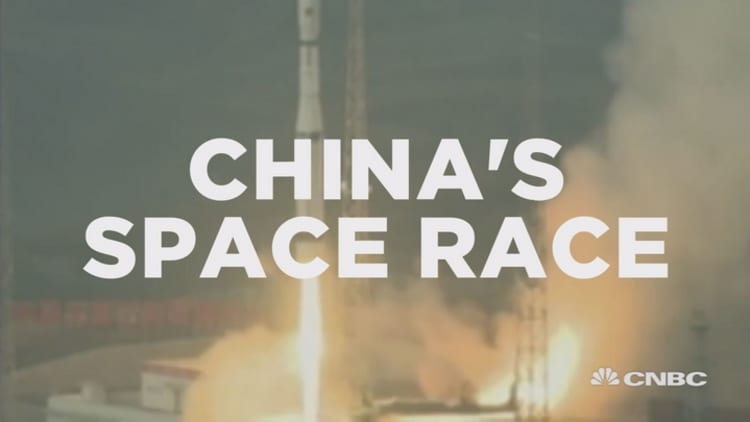A sequel to "Star Wars" may arrive sooner than anyone expects, as China funnels vast resources into an outer space program that may stoke new tensions with the United States.
The country plans to launch more than 20 space missions in 2016, making the year ahead the busiest ever for the nation's rapidly growing space program. After successfully launching 19 missions in 2015, the People's Republic plans a range of civilian and military missions that will test new rockets, launch a space laboratory, hone China's manned spaceflight capability and loft new satellites into orbit — all while furthering plans to bring a habitable space station online by 2022 and put Chinese astronauts on the moon in the mid-2020s.
At the same time, the Asian colossus is investing in anti-satellite technologies that would destroy or disable space-based assets in the event of conflict. Considering the fact that the U.S. relies upon satellites for a lot of its intelligence collection and communication, it's a worrisome trend.
And it is exacerbating tensions with U.S. defense officials and security analysts concerned by China's focus on enhancing its military capabilities in space.
Behind the red curtain
Right now China spends $2 billion to $3 billion on its space program annually, a fraction of the $19 billion NASA will spend this year. Although China remains decades behind the U.S. in terms of space technology and know-how, it has managed to fast-forward innovation by leveraging existing technologies and its inexpensive labor and material markets.
The strategy is working: Over the last 15 years, it's been able to start closing the gap with U.S. and Russian rivals — likely helped along by funding from the Chinese military.
The accelerating tempo of China's civilian space activities now presents a further threat to U.S. space dominance. The fear is that at some point in the foreseeable future, the Chinese could overtake — and even rocket past — the U.S. industry.
"You've got this combination of civilian projects for prestige and military projects for power," said James Andrew Lewis, a senior fellow and director of the Strategic Technologies Program at the Center for Strategic and International Studies (CSIS). "It shows that the Chinese are moving to be a leader in space — if not the leader."

Among the 20-plus launches scheduled for this year are maiden flights of China's Long March 7 and Long March 5 rockets, the latter being its heaviest and most technically sophisticated rocket to date.
China will launch communications and Earth-imaging satellites into orbit for Argentina and Belarus (marking the first time China has exported a satellite to Europe) as well as several satellites of its own. At least two scientific satellites, two navigation satellites and three spacecraft to augment China's High-Resolution Earth Observation System are slated for launch before the end of the year.
The most visible and most ambitious mission will launch in the second half of the year, when a Long March 2F rocket sends the Shenzhou XI spacecraft and its crew of three astronauts to dock with China's Tiangong 2 space laboratory, a habitable module that will launch into orbit separately sometime in the first half of the year.
Tiangong 2, while not designed for long-term habitation, is an important steppingstone toward building a Chinese space station that can be inhabited long term, similar to Russia's Mir or the International Space Station.
The Shenzhou XI mission will allow Chinese scientists to research technologies and identify potential engineering flaws or other issues before launching the core module of its permanent space station sometime later this decade. If the schedule holds, China hopes to have its very own space station online by 2022 — a space station that some security analysts worry could be used for military applications.
Those missions will join an already lengthy Chinese mission portfolio as several ongoing science and technology programs launched in previous years continue to progress. Those missions include a lunar orbiter that is presently scouting locations for a future robotic landing on the lunar surface (likely in 2017) that will pave the way for Chinese astronauts to land on the moon by the mid-2020s — a feat that would make China the only nation capable of putting astronauts on the moon a full five decades after Americans terminated the Apollo program.
"The significance of all this is that China clearly intends to have a competitive space capability," said Dr. John Logsdon, a space policy expert and professor emeritus at George Washington University. If the Chinese hit all the milestones they've set for themselves, they'll still be where the U.S. and Soviets were three decades ago, but they'll also have ticked many of the boxes on the modern space-power checklist.
"These are steps in the logical development of a highly capable space program," Logsdon noted. "They're not successes or milestones to get worried about as long as our own program moves forward."
You've got this combination of civilian projects for prestige and military projects for power.James Andrew Lewisdirector, Strategic Technologies Program, Center for Strategic and International Studies
Given the huge lead the U.S. enjoys over China in space in the entire spectrum of technology and capability, the notion of China's space program leapfrogging the United States' in the foreseeable future is somewhat alarmist, Logsdon said. But the fact that China's civilian space program is so closely linked to its military space activity is worrisome, particularly for the U.S.
Alongside its civilian and scientific space programs, China has invested heavily in anti-satellite technologies that would destroy or disable space-based assets in the event of conflict — weapons like ground-based missiles capable of destroying targets in orbit, as well as experimental lasers and signal jammers that could disable or otherwise "blind" satellites that can be used in a military conflict.
In 2007, China publicly demonstrated one such weapon by launching a ground-based interceptor missile at one of its own defunct satellites in orbit, destroying it (and creating a cloud of dangerous space debris). The test was largely viewed as a shot across the bow for U.S. military planners that rely heavily on military satellites for everything from navigation and communication to intelligence gathering, weapons targeting and piloting its drone aircraft.
While the Pentagon retains its own means of interfering with an adversary's satellites in orbit — including ship-based anti-satellite missiles — U.S. military and commercial interests maintain a far greater presence in orbit and thus have the most assets to lose there.
"There are a lot of avenues to go after satellites, and what worries people is that the Chinese are pursuing all of them," CSIS's Lewis said. "The question becomes: If they're so into peace, why are they building so many weapons?"
What lies ahead?
The uptick in Chinese space activity has political ramifications as well, Lewis said, even on the purely civilian side of things. In the last space race, putting astronauts on the moon represented the pinnacle of space-based capability, catapulting the U.S. ahead of the Soviet Union in terms of international prestige.
With the U.S. space program now focused on abstract goals like a manned mission to Mars at some vague point in the future, China is making concrete plans to return humans to the moon at a time when U.S. astronauts rely on the Russian Soyuz spacecraft for rides to the International Space Station.
"The Chinese are persistent and will probably get back on the moon before we do, so in round two of the space race, we come in second place," Lewis said. "When China lands on the moon and we aren't there, what's the world going to think?"
But the Chinese space program still remains several years away from doing so, and in the meantime, its increasing presence in space also creates room for cooperation if China and the U.S. can push past their mutual distrust on national security matters. While the military aspects of Chinese space ambitions need to be monitored and understood, Logsdon said, the best way to do that is to engage with the Chinese and their space program.
"We can get more done if countries in space work together," he said. "The days of one country being the dominant space power are behind us."
— By Clay Dillow, special to CNBC.com




